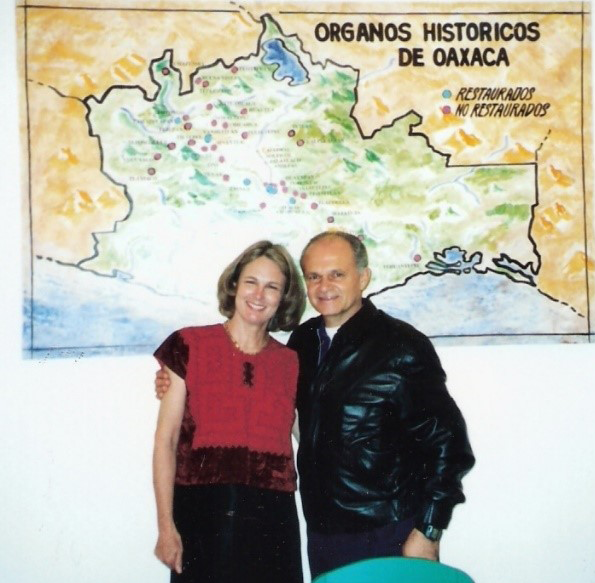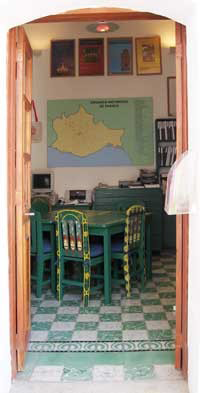|
ABOUT THE IOHIO
Background
Beginning in the 1980s, a growing national awareness and appreciation of historic organs led to restoration projects all over Mexico. In Oaxaca, eight organs were restored, reconstructed, or repaired during the period 1991 to 2003; five of them were financed by Banamex (Banco Nacional de México) thanks to the initiative of philanthropist and music lover Alfredo Harp Helú. Yet once restored, these beautiful instruments were rarely heard after their inaugural concerts and within a short time, began to show signs of deterioration from lack of use. Besides this, local organists in general preferred to play electronic organs, since the characteristics of the antique instruments - meantone temperament, lack of pedals, and a single 45 note keyboard with a short octave - limited the musical options of the modern liturgy, weddings, and other church celebrations. But for those organists passionately interested in early music, the Oaxacan organs offered a rare opportunity to play and hear historic repertoire on relatively authentic instruments.
The co-founders meet and begin to organize concerts
One of these was Edward Pepe, a specialist in the historic organ repertoire and co-founder and co-director for many years of the Westfield Center for Early Keyboard Studies. By chance he had been spending time in Oaxaca and was interested in playing the organs. Pianist and harpsichordist Cicely Winter had been a resident of Oaxaca since 1972 and had organized community service projects while raising her family. Through the work of her husband, archeologist Marcus Winter, she was familiar with issues related to the protection of the national heritage. However, she had never played an organ so Ed showed her how.
Together with another organist friend, they decided to organize a concert in San Jerónimo Tlacochahuaya on February 5, 2000, which later became an important date for the future IOHIO. Hundreds of people attended, including Don Alfredo Harp and his wife, Dra. María Isabel Grañen Porrúa, and by the end of the concert the audience was on its feet shouting with excitement. People were clearly most anxious to hear the organs, which in most cases they had only read about. After this initial success, it was impossible to resist organizing more concerts on other organs, which always elicited the same fervent response.
The IOHIO is founded and flourishes
  It was evident that this energy needed to be focused through a formalized project. Sr. Harp offered office space in the Museo de Filatelia (MUFI) and support for operating expenses of a project directed by Ed and Cicely. And so it was that in the summer of 2000 el Instituto de Órganos Históricos de Oaxaca A.C. (Asociación Civil or non-profit) was created based on the combined experience and complementary skills of these three people. It was evident that this energy needed to be focused through a formalized project. Sr. Harp offered office space in the Museo de Filatelia (MUFI) and support for operating expenses of a project directed by Ed and Cicely. And so it was that in the summer of 2000 el Instituto de Órganos Históricos de Oaxaca A.C. (Asociación Civil or non-profit) was created based on the combined experience and complementary skills of these three people.
As the word spread about the initial success of the IOHIO and its growing network of support, organist friends were drawn to Oaxaca by the opportunity to play concerts on Iberian-style baroque instruments. Before long, these individual presentations were expanded into an International Organ and Early Music Festival, which since 2001 has attracted nationally and internationally renowned artists and has become a highly anticipated and prestigious event.
Protection and conservation
The second priority of our project focused on the unrestored organs and their ongoing protection. Non-functioning instruments continued to be at risk of destruction, especially when the local people did not realize that the old piece of furniture in their choir loft was an organ, let alone have any memory of its sound or historic value. Therefore, the IOHIO, with the support of the Oaxaca INAH office, began to schedule regular visits to these organs in order to document their historical and technical characteristics and to oversee their conservation. With this, our project grew to include a non-musical dimension. Based on our ongoing field work, we have been able to define a protection plan and a documentation methodology for the historic organs in the state.
Evolution of the IOHIO
 In 2004 Edward Pepe left the project to work as an independent researcher and performer at the national level, while Cicely has continued to direct the Institute. In 2004 Edward Pepe left the project to work as an independent researcher and performer at the national level, while Cicely has continued to direct the Institute.
That same year the IOHIO established a Music Academy to teach piano and organ to private students (to finance the project) and to young people from organ villages without charge. Over the course of four years (2004 – 2008), nearly 100 students took music lessons.
In 2017 the IOHIO became financially independent and is now supported by private donors, but still collaborates with the Alfredo Harp Helú Foundation Oaxaca (FAHHO) in various projects.
Our ongoing activities –concerts, festivals, organ lessons, field trips, and presentations— continue to be as efficient and effective as ever.
The IOHIO is unique
• The IOHIO includes a group of capable local organists which play the organs regularly. Churches and communities know that they can ask us at any time for a special mass or concert for local celebrations
• IOHIO organists play the Sunday mass as well as masses for important liturgical events in the Oaxaca Cathedral, the Basilica de la Soledad, and the churches of San Matías Jalatlaco and Santa María Tlacolula.
• The IOHIO Festival has a different character than any other in Mexico, because Oaxaca has so many restored pipe organs to showcase in concerts and even more unrestored instruments to visit during field trips. Only during our festivals can you hear up to nine concerts on different organs in one week.
• The IOHIO is a multi-faceted project. In addition to our musical activities, we are engaged in the technical work of conservation, documentation, and maintenance, community relations in the organ towns, requiring anthropological sensitivity and awareness, and academic research.
The IOHIO’s official status
The Instituto de Órganos Históricos de Oaxaca A.C. is a non-profit organization (Asociación Civil or A.C.) which functions in collaboration with the National Institute of Anthropology and History (Instituto Nacional de Antropología e Historia or INAH, the Mexican institution which oversees the protection of the national heritage), officials of the towns with organs, ecclesiastical authorities, directors and researchers in Oaxaca archives, cultural institutions of the municipal and state governments, and organists, musicians and scholars in Mexico and abroad. The IOHIO’s activities are supported by a Board of Advisors which includes renowned organists, organbuilders, musicologists, and historians.
|

